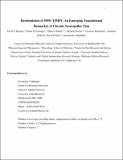| dc.contributor.author | Buckley, David A. | |
| dc.contributor.author | Jennings, Elaine M. | |
| dc.contributor.author | Burke, Nikita N. | |
| dc.contributor.author | Roche, Michelle | |
| dc.contributor.author | McInerney, Veronica | |
| dc.contributor.author | Wren, Jonathan D. | |
| dc.contributor.author | Finn, David P. | |
| dc.contributor.author | McHugh, Patrick C. | |
| dc.date.accessioned | 2020-01-24T14:25:01Z | |
| dc.date.available | 2020-01-24T14:25:01Z | |
| dc.date.issued | 2017-03-30 | |
| dc.identifier.citation | Buckley, David A., Jennings, Elaine M., Burke, Nikita N., Roche, Michelle, McInerney, Veronica, Wren, Jonathan D., Finn, David P., McHugh, Patrick C. (2018). The Development of Translational Biomarkers as a Tool for Improving the Understanding, Diagnosis and Treatment of Chronic Neuropathic Pain. Molecular Neurobiology, 55(3), 2420-2430. doi: 10.1007/s12035-017-0492-8 | en_IE |
| dc.identifier.issn | 1559-1182 | |
| dc.identifier.uri | http://hdl.handle.net/10379/15738 | |
| dc.description.abstract | Chronic neuropathic pain (CNP) is one of the most significant unmet clinical needs in modern medicine. Alongside the lack of effective treatments, there is a great deficit in the availability of objective diagnostic methods to reliably facilitate an accurate diagnosis. We therefore aimed to determine the feasibility of a simple diagnostic test by analysing differentially expressed genes in the blood of patients diagnosed with CNP of the lower back and compared to healthy human controls. Refinement of microarray expression data was performed using correlation analysis with 3900 human 2-colour microarray experiments. Selected genes were analysed in the dorsal horn of Sprague-Dawley rats after L5 spinal nerve ligation (SNL), using qRT-PCR and ddPCR, to determine possible associations with pathophysiological mechanisms underpinning CNP and whether they represent translational biomarkers of CNP. We found that of the 15 potential biomarkers identified, tissue inhibitor of matrix metalloproteinase-1 (TIMP1) gene expression was upregulated in chronic neuropathic lower back pain (CNBP) (p = 0.0049) which positively correlated (R = 0.68, p = ae0.05) with increased plasma TIMP1 levels in this group (p = 0.0433). Moreover, plasma TIMP1 was also significantly upregulated in CNBP than chronic inflammatory lower back pain (p = 0.0272). In the SNL model, upregulation of the Timp1 gene was also observed (p = 0.0058) alongside a strong trend for the upregulation of melanocortin 1 receptor (p = 0.0847). Our data therefore highlights several genes that warrant further investigation, and of these, TIMP1 shows the greatest potential as an accessible and translational CNP biomarker. | en_IE |
| dc.description.sponsorship | This work was supported from grants, including the Pain Relief Foundation, British Pain Society, Science Foundation Ireland (10/IN.1/B2976) and the University of Huddersfield’s University Research Fund. There are no conflicts of interest. | en_IE |
| dc.format | application/pdf | en_IE |
| dc.language.iso | en | en_IE |
| dc.publisher | Springer | en_IE |
| dc.relation.ispartof | Molecular Neurobiology | en |
| dc.rights | Attribution-NonCommercial-NoDerivs 3.0 Ireland | |
| dc.rights.uri | https://creativecommons.org/licenses/by-nc-nd/3.0/ie/ | |
| dc.subject | Neuropathic pain | en_IE |
| dc.subject | Biomarker | en_IE |
| dc.subject | Plasma | en_IE |
| dc.subject | Dorsal horn | en_IE |
| dc.subject | Back pain | en_IE |
| dc.subject | Inflammatory pain | en_IE |
| dc.subject | DIPEPTIDYL-PEPTIDASE-III | en_IE |
| dc.subject | LOW-BACK-PAIN | en_IE |
| dc.subject | NERVE INJURY | en_IE |
| dc.subject | MATRIX METALLOPROTEINASES | en_IE |
| dc.subject | CEREBROSPINAL-FLUID | en_IE |
| dc.subject | GENE-EXPRESSION | en_IE |
| dc.subject | NEURODEGENERATIVE DISEASES | en_IE |
| dc.subject | MELANOCORTIN-1 RECEPTOR | en_IE |
| dc.subject | INDUCED HYPERALGESIA | en_IE |
| dc.subject | MULTIPLE-SCLEROSIS | en_IE |
| dc.title | The development of translational biomarkers as a tool for improving the understanding, diagnosis and treatment of chronic neuropathic pain | en_IE |
| dc.type | Article | en_IE |
| dc.date.updated | 2020-01-23T09:41:43Z | |
| dc.identifier.doi | 10.1007/s12035-017-0492-8 | |
| dc.local.publishedsource | https://doi.org/10.1007/s12035-017-0492-8 | en_IE |
| dc.description.peer-reviewed | peer-reviewed | |
| dc.contributor.funder | Pain Relief Foundation | en_IE |
| dc.contributor.funder | British Pain Society | en_IE |
| dc.contributor.funder | Science Foundation Ireland | en_IE |
| dc.contributor.funder | University of Huddersfield | en_IE |
| dc.internal.rssid | 14102118 | |
| dc.local.contact | Michelle Roche, Physiology, Rm2002 Human Biology Building, National University Of Ireland G, University Road. 5427 Email: michelle.roche@nuigalway.ie | |
| dc.local.copyrightchecked | Yes | |
| dc.local.version | ACCEPTED | |
| dcterms.project | info:eu-repo/grantAgreement/SFI/SFI Principal Investigator Programme (PI)/10/IN.1/B2976/IE/The role of the endocannabinoid system in anxiety-induced modulation of pain: sites and mechanisms of action/ | en_IE |
| nui.item.downloads | 442 | |


